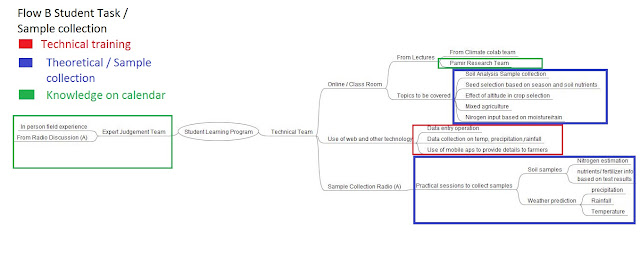Algae Frames, Dung Cake based thermal insulation
Algae Frame based home / Animal Dung Cake based walls and floor. We can have houses
having sides of the wall with algae frames/ cow dung cake, along with the
base. It is based on greenhouse effect when algae used and cow dung
will act as insulator. The algae grown can be used to produce bio
diesel and for cattle feed. A small wind mill and solar panel,can be used at the top, or a group of houses can have solar panels and others can have wind mills.
The use of algae in snowy region needs to be checked, but along
with frames, the mini green house, we can grow algae
http://earthsky.org/human-world/artificial-light-plant-growth
the frames can be attached to the sides of the walls.We can use algae frames http://randomthoughtsofvramanu.blogspot.in/2014/09/algae-frames-approach-to-reduce-global.html
as layer above the dung cake, or outside the houses. when they are used inside the house, probably we need to have some opening for the sun from the top of the tent a chimney vent. The light with in the house as well helps them to grow http://www.sciencedirect.com/science/article/pii/S221192641300091X
The dung based lining should be good, check http://www.arvindguptatoys.com/arvindgupta/ancientfutures.pdf this says how important the dung cakes are for Ladakh culture during winters, this is a place where weather conditions are quite extreme, a time worth article for this challenge please go through it.
We can use the dung paste as coating on the houses which needs to be tested, from this article it is clear that the dung cake paste are used in buildings in villages, esp in Himalayas which is coldest part of India http://www.simplysimple.info/cow-dung-and-its-uses/ they serve as plasters as well.
If we can use a normal flooring above the the dung cake flooring, i think it should be fine, the dung cakes are solid and water doesn't seeps through it. If we require we can have an out let in the floor by drilling a hole at one of the corners of the houses. So that water can pass through it.
http://en.wikipedia.org/wiki/Cow_dung
http://strawbale.pbworks.com/w/page/38537742/Cow%20dung%20%20mud%20paste
When we mount the wind mill and solar panel we need to have adequate spacing between the houses, alternatively, we can space them out and have it. say we can have 4 or 5 houses having powered by a windmill and same for the solar cells so we can mount them nearby the houses so we need not load the tents by their weight.
How to choose a power unit http://www.otherpower.com/popup.html
Build your windmill book - We can give this task to electrical students of central asia university along with some guidance,so we can use the exiting resource, so in future we can use them in other places. There are some organizations and authors who have written books on building wind mills, probably their team can help on this.
Home brew Wind Power: http://www.amazon.com/dp/0981920101/ref=cm_sw_su_dp
Wind Power Workshop: Building Your Own Wind Turbine http://www.amazon.com/Wind-Power-Workshop-Building-Turbine/dp/190217562X/ref=pd_sim_14_5/192-8740813-5891554?ie=UTF8&refRID=16X2V6BD5XYVWR04PMNR
Regarding flooring and walling:
It is been mentioned that walls can be made as per our needs "Specialty Walls" http://www.stuartrental.com/faq/tenting-101, so we probably can have wood based walls at two side and then have them coated with dung cake insulators or just have the floors with dung cake insulators and keep the walls with usual tent materials or we can give a coat of dung paste on these fiber as mentioned in above links, dung paste is been used as an insulation in huts.
But i feel dung-cake flooring should be enough to have produce an effect http://www.weatherquestions.com/What_causes_fog.htm as we are keeping the surface relatively insulated, in the case of walls its been said that Hilleberg Kerlon 1800 silnyon is the best fabric. This is been used in mountains. Probably we may not need that http://www.outdoorgearlab.com/4-Season-Tent-Reviews
- Other use full
resources:
http://www.tentipi.com/public/Design_features_fabrics_pdf_6ghq4nesp30g844o00skkosw/Design_features_fabrics.pdf
http://us.hilleberg.com/EN/our-tents/tearstrength.php
http://www.walltentshop.com/platform.html
http://www.walltentshop.com/Catframes.html
http://www.ankn.uaf.edu/publications/vs/tents.html
- We can use magnifying glass above the solar array of cells,
probably it will help in capturing more energy esp in
winter http://www.quora.com/Will-using-a-magnification-glass-on-solar-panel-increase-the-output-of-the-panelwe
can rotate the solar panel set up based on some gear arrangement
which is driven by solar radiation intensity, so that it follows
the sun and shade is minimized in the colder region, along with
wiper arrangement we can ensure snow gets cleared, with this
arrangement we can have a better output with solar cells. In hooter
regions we can have a normal set up.
Cow dung :
Algae frame based
solution:
http://randomthoughtsofvramanu.blogspot.in/2014/09/algae-frames-approach-to-reduce-global.html
Other References
- Cow dung walls and floor as insulation http://www.simplysimple.info/cow-dung-and-its-uses/


